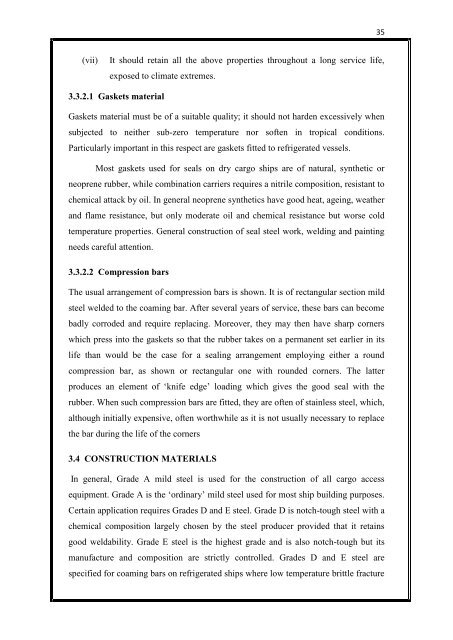Single pull macgregor type hatch cover.pdf - Cochin University of ...
Single pull macgregor type hatch cover.pdf - Cochin University of ...
Single pull macgregor type hatch cover.pdf - Cochin University of ...
Create successful ePaper yourself
Turn your PDF publications into a flip-book with our unique Google optimized e-Paper software.
(vii) It should retain all the above properties throughout a long service life,<br />
exposed to climate extremes.<br />
3.3.2.1 Gaskets material<br />
Gaskets material must be <strong>of</strong> a suitable quality; it should not harden excessively when<br />
subjected to neither sub-zero temperature nor s<strong>of</strong>ten in tropical conditions.<br />
Particularly important in this respect are gaskets fitted to refrigerated vessels.<br />
Most gaskets used for seals on dry cargo ships are <strong>of</strong> natural, synthetic or<br />
neoprene rubber, while combination carriers requires a nitrile composition, resistant to<br />
chemical attack by oil. In general neoprene synthetics have good heat, ageing, weather<br />
and flame resistance, but only moderate oil and chemical resistance but worse cold<br />
temperature properties. General construction <strong>of</strong> seal steel work, welding and painting<br />
needs careful attention.<br />
3.3.2.2 Compression bars<br />
The usual arrangement <strong>of</strong> compression bars is shown. It is <strong>of</strong> rectangular section mild<br />
steel welded to the coaming bar. After several years <strong>of</strong> service, these bars can become<br />
badly corroded and require replacing. Moreover, they may then have sharp corners<br />
which press into the gaskets so that the rubber takes on a permanent set earlier in its<br />
life than would be the case for a sealing arrangement employing either a round<br />
compression bar, as shown or rectangular one with rounded corners. The latter<br />
produces an element <strong>of</strong> ‘knife edge’ loading which gives the good seal with the<br />
rubber. When such compression bars are fitted, they are <strong>of</strong>ten <strong>of</strong> stainless steel, which,<br />
although initially expensive, <strong>of</strong>ten worthwhile as it is not usually necessary to replace<br />
the bar during the life <strong>of</strong> the corners<br />
3.4 CONSTRUCTION MATERIALS<br />
In general, Grade A mild steel is used for the construction <strong>of</strong> all cargo access<br />
equipment. Grade A is the ‘ordinary’ mild steel used for most ship building purposes.<br />
Certain application requires Grades D and E steel. Grade D is notch-tough steel with a<br />
chemical composition largely chosen by the steel producer provided that it retains<br />
good weldability. Grade E steel is the highest grade and is also notch-tough but its<br />
manufacture and composition are strictly controlled. Grades D and E steel are<br />
specified for coaming bars on refrigerated ships where low temperature brittle fracture<br />
35

















